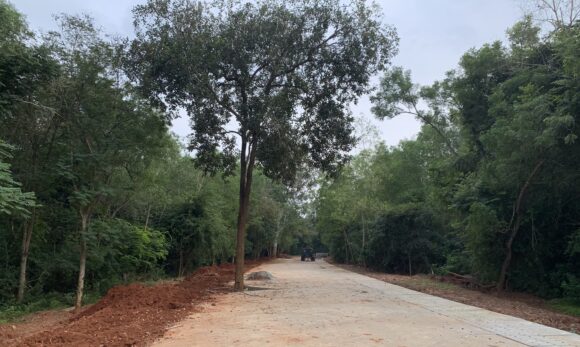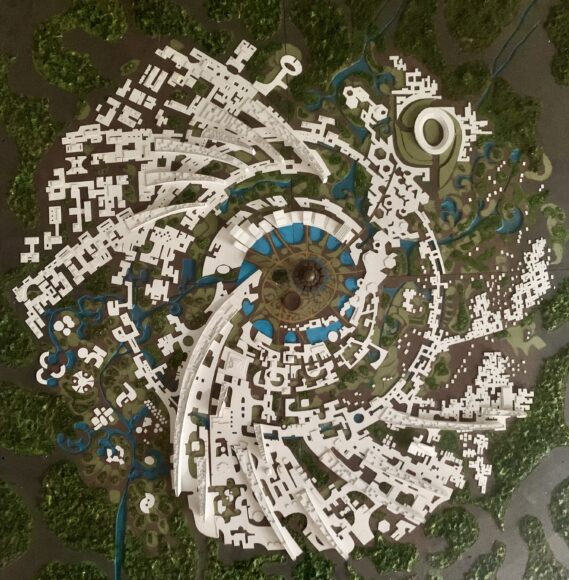
Auroville is a completely unique place, with a rich history and a complex reality. I have only begun to understand it, but one thing that is clear to me is that Auroville is at a key point in its evolution.
If you go to Auroville, you will be struck by its bucolic setting. One travels by scooter or bicycle on red dirt paths winding through a lush forest dotted with little compounds dedicated mostly to cultural, spiritual or educational purposes, along with residences and cafes.
Beyond its physical layout, Auroville is a place made special primarily by the fact that it attracts people with spiritual openness and curiosity who are interested in learning, growth and giving. That alone generates a particular feel and is enough to set it apart from the rest of the word as we know it.
But it does not seem likely that Auroville will be able to stay the way it is, as a little outpost suspended in time in a furiously changing context, for very long. The big question is how it will evolve next.
The original vision was never for Auroville to be a rural settlement for a couple of thousand alternative-minded folk. It was founded by the Mother to be a city of 50,000 that would be a sort of laboratory for mankind, a living model based on spirituality and lovingkindness that could act as an example for the rest of the world.
After a long history of litigation and delay, there is some impetus to move forward toward the vision. A mobility model to underpin the next stage of implementation of the urban vision has been developed. Bits of a circular road that will act as a main artery are beginning to materialize among the trees. A master plan that fleshes out many aspects of the original design has been drawn up and debated. It seems now that things are moving toward implementation, but nothing is simple in Auroville.

Independently of this, things are changing for Auroville because it has become – not necessarily by intention or desire – a tourist destination.
More than 700,000 tourists came to Auroville last year and the number is rising rapidly. Conflicts have arisen as some people would like Auroville to remain peaceful and dedicated to its spiritual mission while others have powerful economic interests to see tourism be developed. Some initiatives exist to try to stem or redirect the tide, but these seem neither consensual nor well-organized. It seems most likely that Auroville will continue to slowly slide toward being a small community heavily dominated by mass tourism’s seemingly irresistible economic might.
Finally is the geographic context. Where Auroville may have once felt remote and isolated, but that reality is changing fast. The community is in the process of being swallowed up within the fast-growing Puducherry metropolitan region.
Auroville is between two of Puducherry’s radial arteries, which are both becoming continuous linear settlements. The more urbanized of the two is the coastal road to Chennai, which is a major area for development in Tamil Nadu. The villages around Auroville, including 6 villages within its planning perimeter, are growing quickly. Unless it becomes a completely closed and gated community, there is no way to think of Auroville other than as a part of the Puducherry bioregion.

So what comes next? My guess is that all three dynamics – the building up of Auroville, the intensification of tourism, and the urbanisation of Auroville’s surroundings – will continue apace, while the community strives mightily to maintain the spirit and characteristics of the bucolic Auroville as it exists today.
The desirable outcome is not that a single deterministic vision wins over the others. Cities do not work that way; what gives them their character is the rich interweaving of often contradictory forces. The parameter of desirability lies only in the proper management of these processes, i.e. that enough intelligent decisions are made to inflect each dynamic toward better outcomes.
We can hope that the building out of Auroville’s master plan happens in a way that avoids the community being in stasis, that furthers the urban laboratory part of the vision, and that this dynamic and gaining in mass will help counterbalance the other forces impacting Auroville.
We can hope that tourism will be carefully managed, avoiding large numbers of day trippers in the core of Auroville, striking a balance between the economic development of the urban region and the spiritual sanctity of Auroville proper.
We can hope for structured development of the Puducherry urban region, with well thought-through mobility and other urban infrastructures, with territorial planning for water, vegetation and biodiversity and the protection of soil and biosystems, that supports Auroville and allows for orderly growth around it.
I believe the future of Auroville will be fascinating and, in any scenario, very different to its present. For those of us who believe in Auroville’s vision and its special mission, it is a critical time for good judgment and wisdom so that Auroville can continue to play – and even amplify – its role as beacon for humanity.